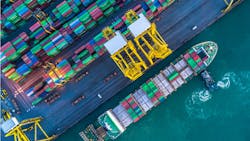Port Congestion Grows Just as Peak Shipping Season Arrives
Download this article in PDF format.
Peak shipping season is here and the container ships are already starting to stack up outside of the nation’s ports, waiting to be able to dock and offload their goods. Even with hints of an economic slowdown in the air, it looks like 2022’s peak season will be just as busy as anticipated, if not more so.
This historically prime shipping time starts in August and runs through October or later. It’s generally driven by school and holiday shopping, but with order backlogs still full and lead times extended, retailers will be sharing space with many other shippers as they try to get their products from origin to destination.
Waiting to Dock and Unload
Last week, the Wall Street Journal reported that a fleet of 40 vessels was waiting off of Georgia’s Port of Savannah, effectively reviving a bottleneck that had cleared earlier this year. This new bout of port congestion also raises concerns about the potential for new supply chain disruptions during the peak shipping season.
A backup of container ships off one of the U.S. East Coast’s busiest ports has swelled to 40 vessels, reviving a bottleneck that had cleared earlier this year and raising fresh concerns over potential supply chain disruptions during the critical peak shipping season.
The port’s executive director said demand is surging earlier this year due to major retailers’ moving up their back-to-school and holiday imports to beat ongoing supply chain challenges.
“The backup at Savannah, which handled some 2.9 million containers last year,” the WSJ adds, “is the latest sign that congestion at U.S. seaports is persisting even as authorities from Southern California to New York are trying to speed up the flow of boxes and keep goods moving.”
West Coast ports appear to be in better shape, at least for now. The publication says that a backlog of vessels at the California ports of Los Angeles and Long Beach—the largest U.S. container import complex—that peaked at 109 vessels in January has receded to between 20 and 24 vessels on most days, and dipped as low as 17 ships in late July. Some of the reduced backlog can be attributed to shippers finding alternate routes into U.S. markets and moving their goods through ports in Georgia, New York and New Jersey.
Transportations Rates are Rising
According to CNBC, the growing port congestion and longer container wait times are driving up ocean shipping spot rates on some trade routes. These one-time-price rates are locked in for specific shipments without the need for long-term contracts. And while there was a slight dip in ocean spot rates earlier, the situation has since reversed itself.
“Global shippers should be prepared for volatility in the coming quarters,” Xeneta’s Peter Sand told CNBC. “I think patience is required, not only in terms of understanding how market dynamics constantly develop, but certainly also to realize that no two markets are alike.”
With the traditional peak season in ocean shipping currently underway, CNBC says that the current backlog of containers at the ports will “only increase congestion and add wait time for incoming vessels.”
Stepping Up to the Plate
Some states are taking new measures to help reduce congestion and enable a smoother flow of goods in and out of their ports. This month, for example, the Port of South Louisiana announced the passage of Act 551, which aims to address supply chain and traffic issues. Signed into law by Gov. John Bel Edwards, the new law allows for the permitting of a single truck driver to haul two containers both headed to a port or to pick up two containers from a port and take them to their destinations.
“From baby formula to fuel, our nation is struggling to get goods to American families,” said Paul Matthews, CEO at the port. “As America’s leading grain exporter, a top energy transfer port and one of the Western Hemisphere’s largest tonnage ports, the Port of South Louisiana is ground zero for getting those goods and products from point A to point B in the most efficient manner.”
Act 551 reduces congestion by cutting the number of truck cabs inside of the port, and may also attract further business to Louisiana ports and away from West and East Coast ports by establishing a system that increases loading and unloading efficiency and decreases shipper transportation costs and delays.






